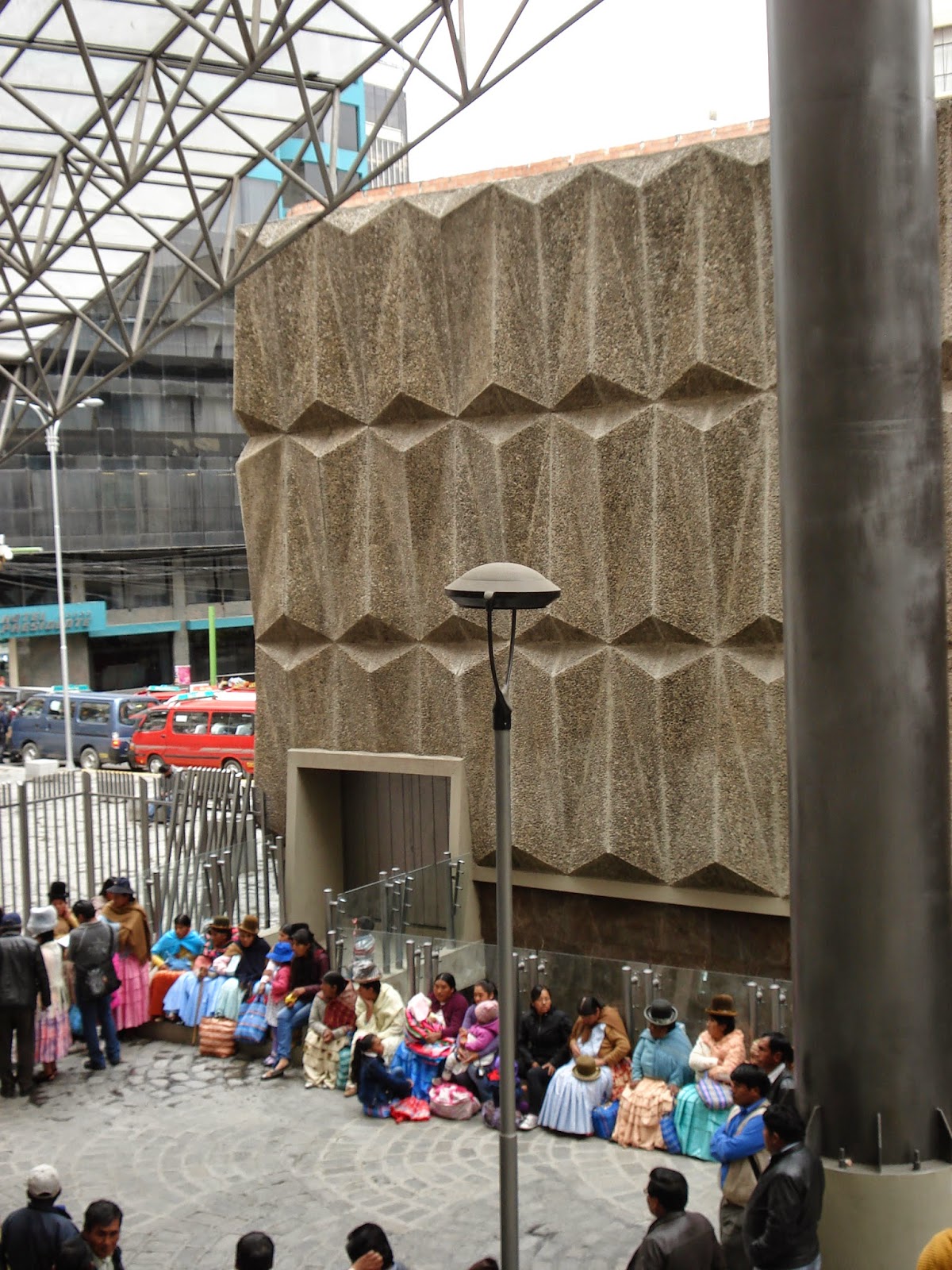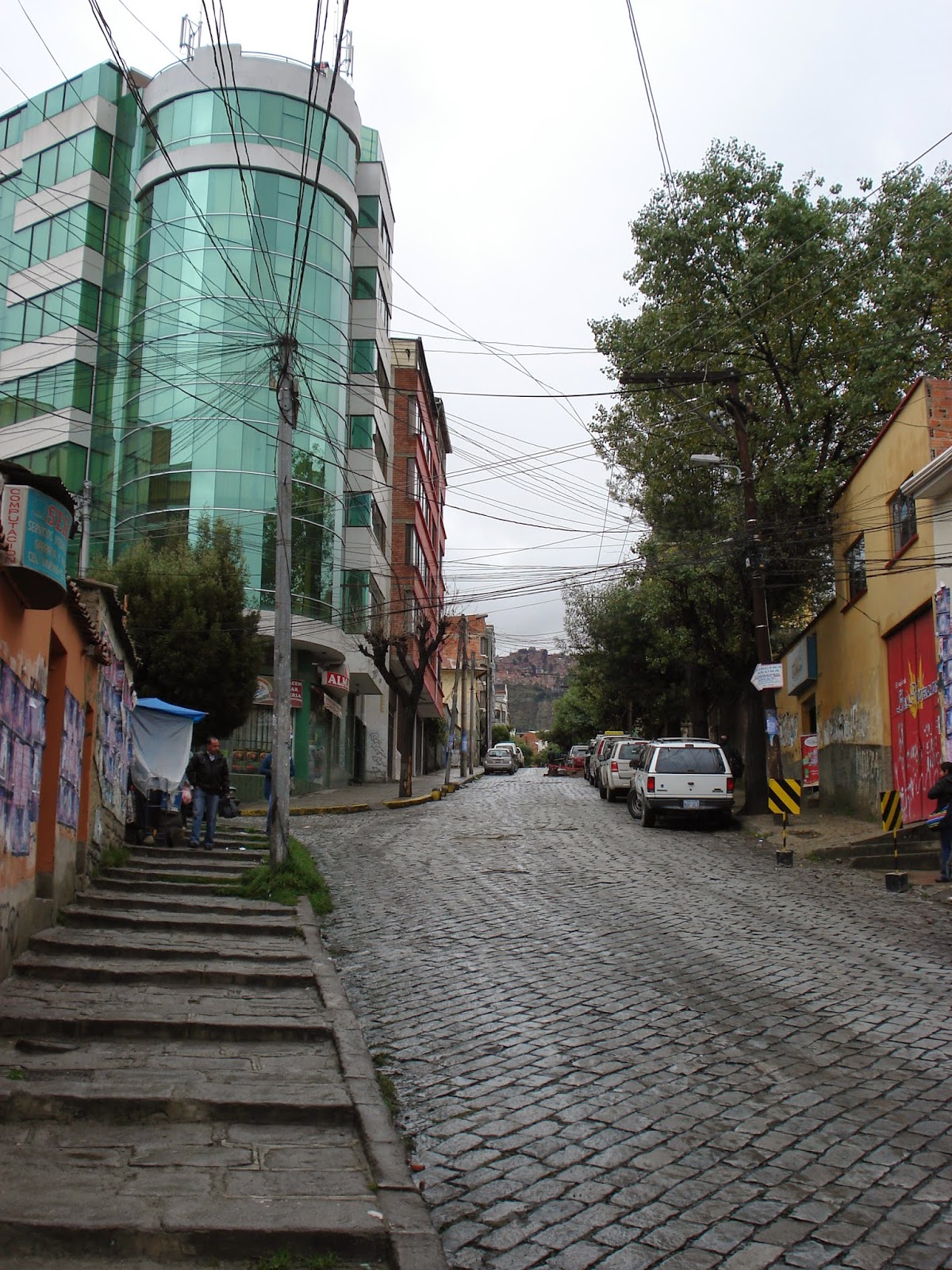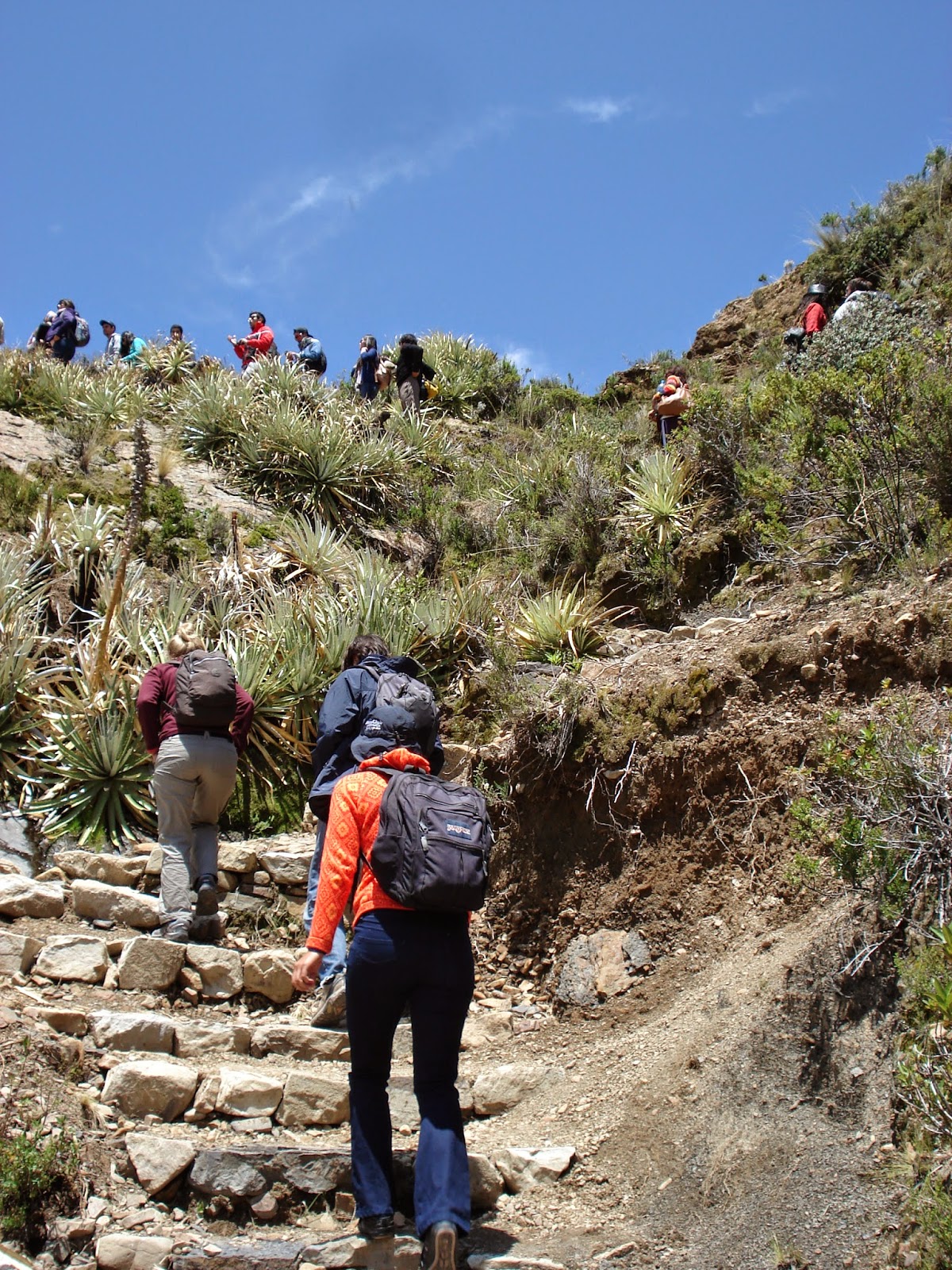After three brief flights (Antofagasta to Iquique, Iquique to Arica, and Arica to La Paz), we arrived in Bolivia. The airport that services La Paz is located on a plato to the west of the city called El Alto. A quick note to all incoming Americans: to avoid the 90-minute delay that we ran into in Bolivian customs, bring crisp dollar bills to pay for your tourist visa. We had neglected to iron our dollar bills and actually had to find a special ATM in the airport that gave US dollars just to appease the customs agent.
After changing the remainder of our greenbacks to Bolivian dollars, we paid $10 to a cabby to take us into the main city and started to look for our hotel.
Somewhere a midst the steep hills and one way streets, we came across our hotel. To the cabby's credit, he got us to the general area, but even equipped with a map and a picture of the front of the hotel, about 45 minutes were lost to stopping every pedestrian we came across until we found someone who knew where the hotel was. Equipped with two $3 umbrellas, we set off to discover La Paz.
We saw many indigenous Bolivians in traditional dress - the men with full three-piece suits and the women with multiple petticoats. In the middle of the city we came across Plaza Murillo, a beautiful pigeon-covered plaza surrounded by historical buildings. In the back right, you will see the Presidential Palace painted a bright orange, and in the back left you will see the National Congress building.
Among some of the less known buildings, we came across a beautiful art gallery adjacent to the Plaza.
Which was of course under construction
One thing I wanted to capture among the short list of photos that made it to the final round of uploading was the constant feeling of history. Several buildings downtown date back over 400 years and the city's approach to maintaining them instead of demolishing them for new 21st-century skyscrapers has left the city with a wonderfully diverse landscape.
I have to admit there were so many of the classical buildings that I forgot a few names in the five months since we went.
Another important aspect to keep in mind is how high up the city is. At 11,900 ft, we had to religiously drink tea from the oja de coca just to keep the headaches at bay. Additionally, we were never without our umbrellas due to the sporadic nature of the weather. What is seen above actually started as a clear day, only to turn into rain after the clouds rolled through the city.
The constant ups and downs at such an extreme elevation left even me feeling exhausted by the end of the day. The millions of miles of electric lines, however, instilled a certain degree of uncertainty on the level of city planning...
For your viewing pleasure. The juxtaposition of mid-80's glass boxes next to late 19th-century was a sight for sore eyes coming from a dust covered mining town.
These well-masked fellows were scattered throughout the city ready to shine your shoes for just about $1. Careful though, as a foreigner you should expect to pay double.
(Insert overly romantic and lame caption here)
Back to the Plaza Murillo, you can see the Cathedral in the background. Raincoats and umbrellas required.
Smog is another overbearing aspect of the city and with all of the public transportation surviving from the 70's, one quickly begins to understand where it comes from. To their credit, the drivers keep these machines well tuned and on schedule. This photo was actually taken with the driver trying to go through me.
Colored powder, one of the many things available in the city markets
From my personal experience, I would not recommend trying to take a photo of one of the vendors without first purchasing something from them. If you do, this will ensue.
Walking through the witch's markets on the north side of the city
If you are planning to build a new house, these are the objects that you bury beneath your foundation to ensure longevity of the home. Before you decide that that is unnecessary, I might recommend some research into the frequency and severity of local mudslides.
A great view taken in during our walking tour. The city has tip-based walking tours that go out from one of the main plazas every day of the week at 10 and 2.
This is the main plaza from which the tour left. Our guide told us that they are known for their three 'P's: Parties, Protests, and Parades.
Van and bus on barge. While we took a private boat to get across Lake Titicaca, our bus took an even more private barge. No passengers allowed.
Finally arrived in Copacabana (Bolivia, not Brazil). No South American city exists without a church.
Firm believers in walking tours, we promptly set out to capture the best views of the city.
The two most important things to keep in mind while viewing this photo in order of importance (most to least): the ice cream cone in the foreground is inedible, and that is Peru in the background.
The view from halfway up
Sometimes looking like a tourist is mandatory. In this instance, it was not.
A view of the bay
A two hour climb? Now just imagine how difficult it was for whoever hiked up with all of the raw materials required to construct the cemetery on top.
Truly a beautiful place to stay
The second day, we headed out to the Isla del Sol.
Halfway to the island
75% there...
And we're off.
The small coves located around the island all seemed straight out of a a tour book just based on the crystal clear waters.
There will come a time to pick a direction. Unfortunately, there was not enough time to explore both routes. For anyone reading this considering a similar journey: we went left.
Almost all of the island had been built up into terraces for farming.
One of the many adobe homes found on the island. Most were attached to small parcels with vegetable gardens.
Another shot showing the strange geography of the island
Unfortunately, we did not come across any "For Sale" signs while wandering around the island.
Most of the ruins on the island date back to the 15th century AD. While these may not have been among the oldest, we found several less advertised historical buildings throughout our walk.
One of the primary species of trees on the island is the Eucalyptus tree. Though I have yet to identify this subspecies, I thought the bark was worth documenting.
Likely due to volcanic activity, nearly all of the island was covered in these "fincas". No one seemed too ready to talk to us during our adventure, but based on the remoteness of the island and the prices we encountered, I suspect that most items grown on the island are consumed there.
These old Mercedes Benz trucks from the '50s and '60s can be found throughout the countryside. Though I noted that they seemed to be running a little rich, I did not find a single one out of commission on the side of the road. I have to wonder how much of the recycling and repurposing that we saw can be attributed to the land-locked status of Bolivia. One would suspect that it puts a damper on imports and exports, leaving people to work with what they've got.
A wonderfully done mural on the downtown amphitheater. This photo highlights both the professional attire that you find throughout the city on nearly everyone, as well as the average height.
The miniature festival that we came across. Miniature swords, miniature houses (burned or buried if you want to have a large house somewhere down the line), and miniature portions of food were all available for the right price.
I happen to have a weakness for Volkswagens. Again, no "Se Vende" signs could be found.
To get around this city filled with deep valleys and steep hills, the city installed some well-designed bridges. The one pictured here spans nearly 400 meters, and at the center is over 200 meters off the ground.
While on first inspection this was thought to be one of the richer neighborhoods, our tour guide said that the property values were kept at bay by the frequency of landslides in the area.
A lesson to all builders and developers: a little color goes a long way. We appreciated the bold pastel colors used to offset the sharp angles of the standard prismatic condos.
Funiculars are fun, when they work. This was as close as we got to the top of the mountain.
After a brief nine day trip, I can honestly say that La Paz and Bolivia as a whole are definitely on the top of my list. Bolivia is a beautiful country that is very affordable for tourists, and filled with friendly Bolivians that speak textbook Spanish in a crisp clear accent.





















































No comments:
Post a Comment